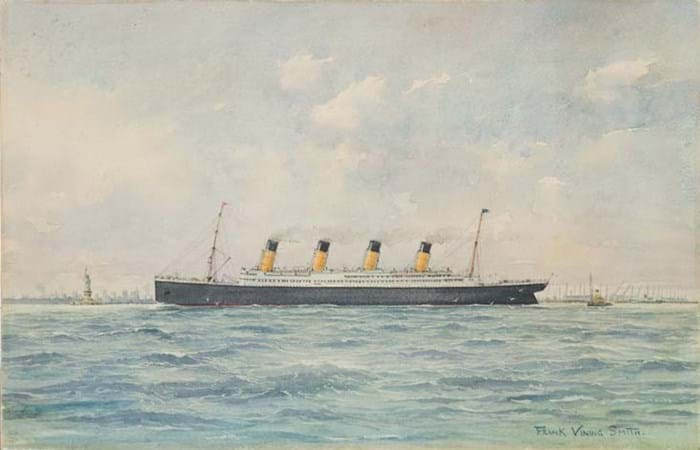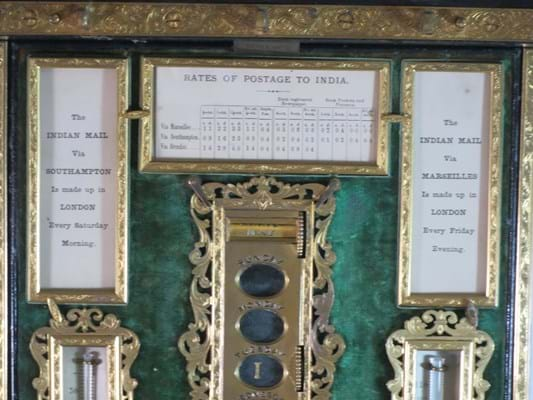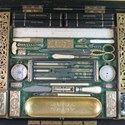Back around 1870, he could make use of seemingly essential items ranging from a compass, barometer, drawing set, thermometer, quill cutter, nib cleaner and a guide to postal rates to India.
And that’s just a few of the items contained in what is described as a ‘magnificent gentleman’s travelling compendium’ made by Asprey, London, which is estimated at £10,000-15,000 in the Charles Miller auction to be held at the 25 Blythe Road auctions ‘hub’ in west London.
Spring stationery racks with inkwells, vesta with sharkskin strike to light a taper (perhaps for the seals also included), thermometer, scissors, ruler, calendar, concealed compartments for jewellery and sovereigns, morocco-bound gilt-edged books for cash, addresses and journal – what more could you want?
“It is just an astonishing thing and looks completely untouched,” said Miller, “even with an amazing flush-fitted device on the top of the lid which you tap and it springs up to give it a carrying handle [the Asprey patent inset spring handle].

The spring handle of the gentleman's travelling compendium by Asprey c.1870 on offer at Charles Miller's auction on May 1 estimated at £10,000-15,000.
“This was consigned by a retired dealer, a collector come dealer really, who had it in his house for 25-30 years and never brought it out. It is in far too good a condition for that, completely unusued. I have to assume it originally had some kind of outer case, canvas maybe, but I don’t know for sure. The condition is amazing.”
Miller added that he has never sold anything like this before. “It is a one-off. You probably see smaller versions on the market but this is probably the largest and best I have ever seen and the refinement and quality of the workmanship is remarkable.”
The fine detail includes engraved lock plates with Bramah locks and the opulenttly worked interior features engraved gilt brass fretwork. The black morocco case with gilt tooling measures a giant 9in x 21in x 3ft 4in (23 x 54 x 1.02m).
Luxury in London
When this ‘compendium’ was made Asprey was based in New Bond Street, London, where the firm moved in 1847. It is still based there. Asprey can trace its origins back to a silk-printing business established in Mitcham (now south London) in 1781. It soon became a luxury emporium.
Not Titanic's last journey

The arrival that never was - Titanic shown steaming into New York, a watercolour on offer at Charles Miller's auction on May 1 estimated at £1500-2000.
As always with Miller’s biannual auctions, the weird and wonderful rubs shoulders with maritime, scientific and fine art highlights. Among the other stand-out lots on May 1 is a watercolour of the ill-fated liner RMS Titanic steaming through the waves, estimated at £1500-2500.
Look a bit closer though at this work by American artist Frank Vining Smith (1879-1967) and something odd appears in the background: the Statue of Liberty in New York. For a now obvious reason, the Titanic never actually made it to NY…
As the catalogue notes: “This interesting view of Titanic was presumably completed to commemorate her successful maiden voyage. The bow is faintly inscribed [SS Titanic], although the covered walkway, which distinguishes her from her sister Olympic, and the limited number of lifeboats on view confirm the attribution. It is possibly a study intended for a larger exhibition format, but is still very detailed with the compass platform etc clearly seen.”
Lack of power

Ship's bell intended for aircraft carrier HMS Powerful in 1945 - a vessel which was immediately mothballed after launch and sold to Canada. Estimated at £1000-1500 in Charles Miller's May 1 auction.
Talking of might-have-beens, estimated at £1000-1500 is a ship’s bell marked for HMS Powerful 1945. So far so good – but the Royal Navy never received Powerful. This bell is for a ship that never existed under that name.
A ‘Majestic’ class aircraft carrier of 20,000 tons, Powerful was laid down at Harland & Wolff in November 1943 and launched in February 1945. With the end of the Second World War and the programme of austerity that followed, work was suspended from May 1946 and the ship mothballed at Belfast.
In 1952 the Canadian Government, looking to replace its ageing carrier Magnificent, bought Powerful for $21m and renamed her HMCS Bonaventure and she served until 1970.













